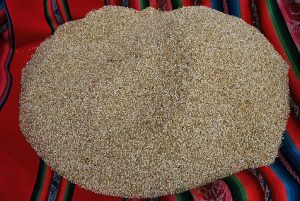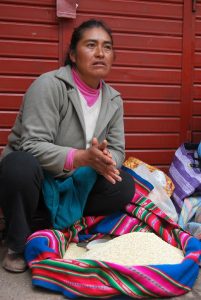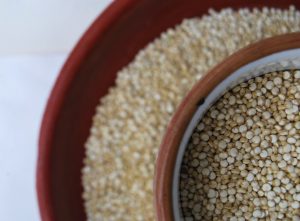Response to the Guardian: Do Not Turn off The Spigots of Quinoa Consumption

A tiny hint of a seed, about an eighth the size of a sequin, quinoa provoked the world’s interest with its might and now the doomsayers have arisen. A recent opinion piece in UK’s Guardian trumpeted an “Unpalatable Truth” that poor Bolivians can no longer afford to eat quinoa because of rising demand for the seed in the West. So we asked around and, no surprise, the situation is far more complex than the one-note Guardian article allows.
The world is celebrating the International Year of Quinoa, right now, proclaimed by the United Nations and motivated by Bolivia’s charismatic and gadfly president Evo Morales. The intent of the day, among other things, is to promote recognition of this Andean seed that has been used for millenia as a staple, both in the Andes and abroad.
The reason for promotion in the Andes is because quinoa “huele a campo” as they say, it “smells of the countryside”, that is to say it carries a stigma as a poor-person’s food or a food appropriate for a rural class of marginalized Indians. Since that is not the way migrants to the city consider themselves, they tend to prefer food with the glitz and glamour of urban style such as bread, rice, French fries, or pasta.
With the International Year of Quinoa, the UN along with Andean leaders, hope to clean quinoa of the scent of campo (like the saponins protecting it from insects that need washing in order for the quinoa to be edible) and give it a fine perfume of ancient high rises, fashion, and modern demand.

Not surprisingly, the International Year arrived along with higher prices for quinoa. The seed runs around S/ 10, about $4 US, a kilo, in the markets of Cuzco. The price of wheat is a third of that. And, the price of quinoa has risen a full 25% since last year.

This would seem to support the Guardian’s allegation that “The appetite of countries such as ours for this grain has pushed up prices to such an extent that poorer people in Peru and Bolivia, for whom it was once a nourishing staple food, can no longer afford to eat it. Imported junk food is cheaper. In Lima, quinoa now costs more than chicken. Outside the cities, and fuelled by overseas demand, the pressure is on to turn land that once produced a portfolio of diverse crops into quinoa monoculture.“
Such breathless imperial romanticism and hand wringing! Sorry to rain on your London pity party, Guardian, but that all is only partially true.
Yes, industrial junk food, whether imported or not is cheaper. Quelle surprise. You cannot keep the goodies of modernity to yourself. Andeans want what you have too. They want your Cadbury, and your Jaguars. They think yours are sexier than the big cats that still slink in the Andean Amazon. Ever since the days when you pushed the railroads deep into the highlands, brought them beer and soda–along with soccer–they have been hooked. Grace and Company did a fine job, stiff upper lip and all.
If you could undo the Enclosure Act you might want to wrest some land back for your peasantry and do a diverse crop multiculture on the fine soil of Avalon.
These days even Andean campesinos want chocolate bars and iPods, even if the latter are only from a former British colony and relatively new Imperial leader. But the draw is not just the sexiness of advertising and some hormonal rush for modernity that Anglo Saxon preaching for the virtues of asceticism can undo.

A population boom hit Andean peasants and, in most areas, they outgrew the capacity of the land to support them. That along with the draw of cities where money could be obtained caused out-migration leading to people having strong ties with urbanites and their life-styles. Money was even more necessary if people wanted an education for their children and so, either they migrated to work, or they sold more of their crops.
Since then drought, civil wars, the cocaine boom, and so on have drawn more and more people from the communities. This is an old story.
The boom in quinoa is not the cause of it. Far from it. The story goes back at least to the days when you encouraged them to monocrop alpaca or to the days before your agricultural revolution when Bolivia’s Potosi was one of the world’s exporters of wheat.
Yes, as your companion piece says, people may be encouraged to sell their entire crop, although I will bet in most cases they keep some land for potatoes for themselves. Money has become that important in rural people’s lives.
The problem is money, not quinoa. They need it. How else are they going to afford text books and notebooks, pens and pencils, not to mention tablets, for their kids’ educations. And, how are they going to feed the habit for industrial goodies like beer and soda? You can not have a fiesta anymore without beer and soda.
However, when we asked around the market, we were told the price rise in quinoa this year is due to a shortage of production, not global demand per se. Last year, we were told, more land that otherwise produced quinoa was devoted to producing cañiwa, another sexy “new” wonder food in the West and in the industrial sectors of the Andes.

As a result, less land was dedicated to growing quinoa and so there is less to go to market. Furthermore, right now is between season. The plants are growing and they have yet to be harvested, since the rains are falling steadily. Let us have this discussion again in July, when fresh harvest quinoa is available.
So Dear Guardian. Please do not turn off the spigots of money for Andean products.The campesinos need the money.
Once you have reestablished that ring of happy, romantic Anglo Saxon peasant multicropping around London we will talk about how campesinos in the Andes should live.




